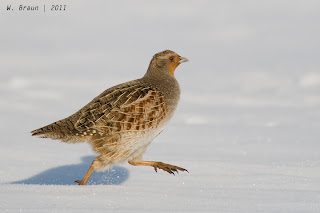The Gray Partridge (Perdix perdix) is a grayish-brownish partridge, a bit larger than a quail. It has a rusty face and chestnut bars on the sides. Both sexes are nearly identical, but the adult male has a distinct horseshoe-shaped, chestnut patch on its breast. When flushed, it displays a short rufous tail.
A native of the bush plains of Europe and western Asia, the species was introduced to central and southern Alberta in 1908 for hunting purposes. Perhaps it came from Hungary; its alternate name is Hungarian Partridge, often abbreviated to Hun – as in a covey of huns. It is now well-established in the prairies and parklands of Alberta.















No comments:
Post a Comment